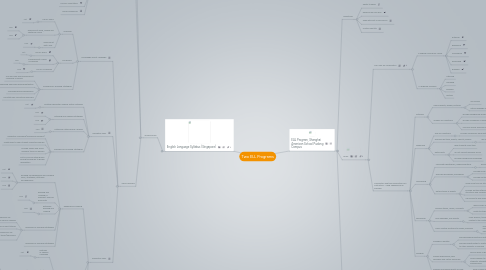
1. English Language Syllabus (Singapore)
1.1. Syllabus Aims
1.1.1. Teaching Processes (ACOLADE)
1.1.1.1. Raising Awareness
1.1.1.2. Structuring Consolidation
1.1.1.3. Facilitating Assessment for Learning
1.1.1.4. Enabling Application
1.1.1.5. Guiding Discovery
1.1.1.6. Instructing Explicitly
1.1.2. Principles of EL Teaching and Learning (CLLIPS)
1.1.2.1. Contextualization
1.1.2.2. Learner Centeredness
1.1.2.3. Learning Focused Interactions
1.1.2.4. Integration
1.1.2.5. Process Orientation
1.1.2.6. Spiral Progression
1.1.3. Skills Assessed
1.1.3.1. Knowledge About Language
1.1.3.1.1. Grammar
1.1.3.1.2. Vocabulary
1.1.3.1.3. Examples of Teaching Strategies
1.1.3.2. Receptive Skills
1.1.3.2.1. Positive Disposition Toward Active Listening
1.1.3.2.2. Listening and Viewing Strategies
1.1.3.2.3. Extensive Listening and Viewing
1.1.3.2.4. Examples of Teaching Strategies
1.1.3.3. Productive Skills
1.1.3.3.1. Reading and Viewing
1.1.3.3.2. Speaking and Representing
1.1.3.3.3. Writing and Representing
2. EAL Program, Shanghai American School Pudong Campus
2.1. Objectives
2.1.1. Ability to apply
2.1.2. Develop real-life skills
2.1.3. Align with rest of curriculum
2.1.4. Nurture identity
2.2. WIDA
2.2.1. The "Can Do" Descriptors
2.2.1.1. 5 English Proficiency Levels
2.2.1.1.1. Entering
2.2.1.1.2. Beginning
2.2.1.1.3. Developing
2.2.1.1.4. Expanding
2.2.1.1.5. Bridging
2.2.1.2. 4 Language Domains
2.2.1.2.1. Listening
2.2.1.2.2. Speaking
2.2.1.2.3. Reading
2.2.1.2.4. Writing
2.2.2. Descriptors and their implications on instruction - using Speaking as an example
2.2.2.1. Entering
2.2.2.1.1. Name objects, people, pictures
2.2.2.1.2. Answer WH questions
2.2.2.2. Beginning
2.2.2.2.1. Ask WH questions
2.2.2.2.2. Describe pictures, events, objects, people
2.2.2.2.3. Retell facts
2.2.2.3. Developing
2.2.2.3.1. Formulate hypotheses, make predictions
2.2.2.3.2. Describe processes, procedures
2.2.2.3.3. Retell stories or events
2.2.2.4. Expanding
2.2.2.4.1. Discuss stories, issues, concepts
2.2.2.4.2. Give speeches, oral reports
2.2.2.4.3. Offer creative solutions to issues, problems
2.2.2.5. Bridging
2.2.2.5.1. Engage in debates
2.2.2.5.2. Explain phenomena, give examples and justify responses
2.2.2.5.3. Express and defend points of view
